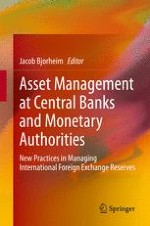2020 | OriginalPaper | Chapter
7. Saudi Arabian Monetary Authority: Why Do Central Banks Hold Domestic and Foreign Currency Assets?
Author : Talal Al-Humoud
Published in: Asset Management at Central Banks and Monetary Authorities
Publisher: Springer International Publishing
Activate our intelligent search to find suitable subject content or patents.
Select sections of text to find matching patents with Artificial Intelligence. powered by
Select sections of text to find additional relevant content using AI-assisted search. powered by
